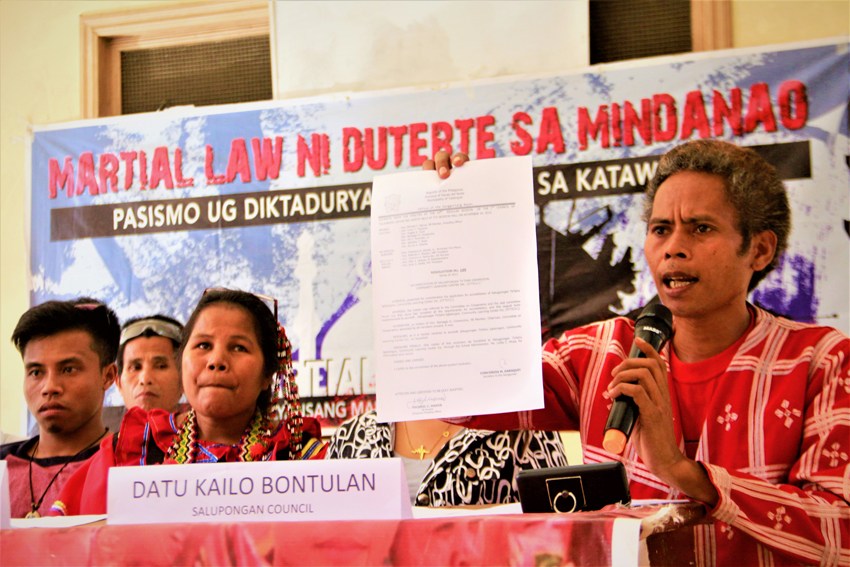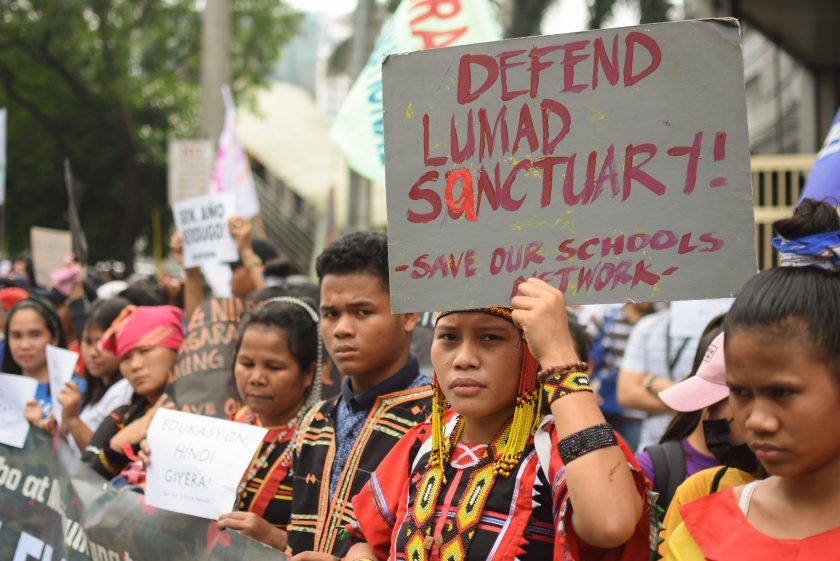“Jesus Christ, himself, taught us to provide protection to his flock, away from wolves and robbers who seek to come and destroy.“
By JANESS ANN J. ELLAO
Bulatlat.com
MANILA – As the democratic space continues to shrink in the Philippines, sanctuaries for the marginalized and the persecuted have been under siege.
Bolo-wielding members of paramilitary group Alamara greeted families of indigenous peoples seeking refuge at the United Churches of Christ in the Philippines – Haran compound in Davao City in the morning of Jan. 25. Their attempt to tear down the walls of the compound were met with strong outcry as the internally displaced Lumad seeking refuge there rushed to protect what they consider as their “second home.”
Read: IP leader defends UCCP Haran, calls it ‘a second home’
The attack came days after the regional peace body ordered the shutting down of the church compound, where some 500 individuals are seeking refuge, of which 236 are infants and children, according to human rights group Karapatan.
Intense militarization of their ancestral domains – often resulting to grave rights abuses such as killings, enforced disappearances, threats, and harassments – had driven these Lumad families away from their land and livelihoods. But state forces seem ever determined to go after them, even when they are housed in a sanctuary.
Read: The State’s Strategy Against Lumads
“The forced intrusion of Alamara group in the compound of UCCP-Haran could not have happened without the prodding of those who initiated the resolution,” said the UCCP in a statement, adding that despite the fact that it was unlawful, the illegal intruders have yet to be apprehended.
The UCCP Council of Bishops said, “we deplore such inaction and fumbling on the part of the police.”
Providing sanctuary

In an attempt to cover up their forcible entry on the Lumad sanctuary at the church compound, several local government officials attempted to paint the displaced tribal families as “captives” of the UCCP, who, they said, exploits them. A ranking police officer, too, said the attempt to break into the church compound was not an attack by Alamara but rather an attempt to “rescue” their family and relatives.
Capt. Roberto Escalona of the Philippine Army’s 10th Infantry Division was even quoted as saying in a news report that the UCCP is using the “cloak of religion” to continue its operation.
But UCCP’s Council of Bishops, in a recent statement, stressed that the church compound is not a “mere evacuation center” but rather a mission house inspired by the UCCP’s 1990 action declaring its churches and facilities as “sanctuaries and zones of peace.”
Haran, which stands for “Home and Altar for Renewal, Action, and Nurture,” has long been considered a sanctuary for internally displaced indigenous peoples and human rights defenders in distress.
“The Regional Council has no right whatsoever to demand the closure of a church’s mission, much more to blame a church for faithfully doing its Christian mission of defending the poor and the oppressed,” the statement of the Council of Bishops read.
Church as persecuted
From medieval to recent history, the role of sanctuaries – most especially those provided by churches and religious movements – has been documented in many parts of the world. The act of providing sanctuaries to the persecuted has been crucial in securing their safety, which later served as crucial turning points of history – such as the ending of slavery, segregation, and in exposing human rights violations.
In the Philippines, Fr. Jonash Joyohoy, Ramento Project for Human Rights Defenders executive director, noted that many churches and religious convents have opened their doors to human rights defenders in distress.
For the past decade, the RPRD, the human rights arm of the Iglesia Filipina Independiente’s Diocese of Rizal and Pampanga, has been facilitating the provision of sanctuaries for human rights defenders under attack from various dioceses and churches.
Ironically, at one point in history, Fr. Joyohoy said the Church itself experienced centuries of persecution, prior to the conversion of Constantine. The Bible, too, he added, is also laden with stories of people seeking sanctuaries.
“Jesus Christ, himself, taught us to provide protection to his flock, away from wolves and robbers who seek to come and destroy. This is the basis why we defend the defenders,” he said.
A community of human rights defenders
Fr. Joyohoy said they consider the internally displaced Lumad families seeking shelter in churches as a community of human rights defenders.
“These indigenous peoples did not only leave their homes to flee from harassment and violence. Seeking a sanctuary, too, is a form of rising as they bring their plight to the public’s attention, especially those of the powers that be,” he told Bulatlat.
The recent attack, however, on the UCCP compound is not just a harassment but also an act to threaten internally displaced Lumad families that they are not safe even in these sanctuaries.
The United Nation’s Guiding Principle on Internally Displaced Peoples states that persons engaged in humanitarian assistance should be respected and protected and “not be a subject of attack or other acts of violence.”
Karapatan said, the Duterte administration has “long desired to undermine the resistance of Lumad communities, including delegitimizing their struggle for self-determination.”
This, the group added, is proof that martial law in Mindanao has only been lifted on paper but “country remains under the firm grip of a de facto military rule.”
Meanwhile, the UCCP, per the statement of its Council of Bishops, is resolute in carrying out their “mission of serving the poor and the oppressed.”
The post Why the PH gov’t should leave Lumad sanctuaries alone appeared first on Bulatlat.





